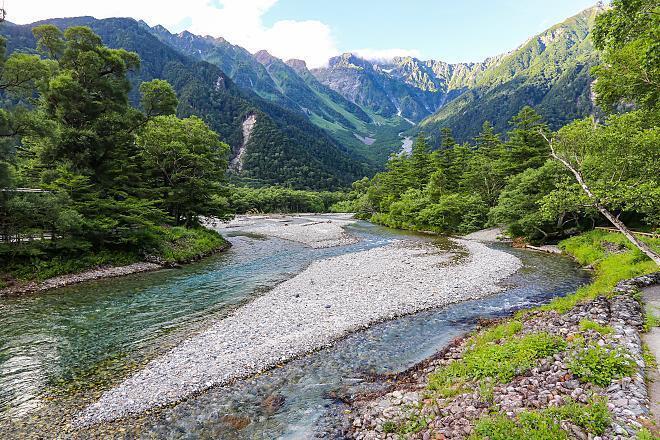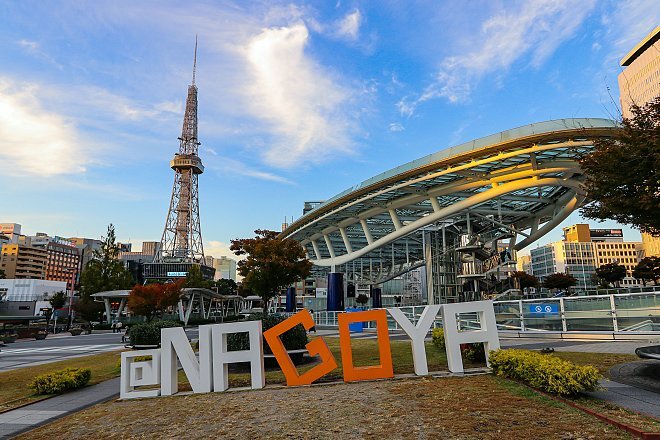Spring in Japan is synonymous with cherry blossoms, and the sight of the open blossoms is something locals and tourists look forward to when the flowers are in bloom for a brief one to two weeks. For this article, I went on a journey through central Japan and visited some of the best cherry blossom viewing spots in the region. Along the way, I also made sure to sample the local food and drink.
My journey started at Chubu Centrair International Airport, and I took the airport limited express train into central Nagoya.
Day 1: Parks in central Nagoya
Upon arrival at Nagoya Station, I put my luggage in a locker before taking the subway to the Yamazaki Riverside, my first cherry blossom spot for this trip. Around 600 cherry trees can be found along a 2.5 kilometer stretch of the Yamazaki Riverside. Not only is this one of Nagoya's most popular cherry blossom spots, it is also selected as one of Japan's top 100 sakura spots.
Hanami means flower viewing, but more often than not, the term is synonymous with cherry blossom viewing. There're are no set rules on how to do hanami, but the following two are the most common ways. First is simply walking and looking at the flowers, which was what I did, and second is picnicking under the cherry trees. Several bridges along the riverside provide nice vantage points for viewing the sakura.



After that nice walk down the riverside, I took trains to Tonpachi, a tonkatsu and misokatsu specialty store that has been in business since the early 80s. Tonkatsu or deep fried pork cutlets are popular nationwide, and misokatsu, in which a savoury miso sauce is poured over the fried pork, is a Nagoya favourite and specialty. At Tonpachi, hacchomiso, an additive-free local miso made only with soy beans and salt, is used to make its characteristically rich miso gravy.

A short walk from the restaurant is Tsuruma Park, which opened as Nagoya City's first public park in 1909 and contains both Japanese and Western style garden elements. The park contains over 700 cherry trees making it a prime hanami spot and another of Japan's top 100 sakura spots.
Tsuruma Park is a popular place in central Nagoya to do yozakura, which is viewing the sakura at night. During the cherry blossom season, the cherry trees in the park are illuminated at night, and there are plenty of food trucks and vendors offering food and snacks. I joined the yozakura crowd and found myself a nice spot in the park to enjoy the illuminated blossoms and street food from the food vendors. Most parks have local rules about enjoying the cherry blossoms so that everyone can have a good time, which at Tsuruma Park include not having rowdy parties, not entering the protected cherry tree areas and making sure not to litter.


Day 2: Sakura, samurai and castles in Mie
Approximately one hour by train south of Nagoya, Matsusaka City is best known for its local wagyu, Matsusaka Beef. After arriving at Matsusaka Station, I took a 15 minute walk from the station to Matsusaka Park, where the ruins of the city's former castle remain. The castle was built in just three years during the late 16th century, but only the stone walls remain today. About 300 cherry trees can be found on the former castle grounds, and there's something sentimental about pairing over 400 year old stone walls with the fleeting sakura blossoms.
Within the former castle grounds stand two rare, surviving examples of large residences for low-ranked samurai, who served to guard the castle during the feudal ages. The longish buildings each contain multiple apartments, most of which remain privately owned, except one unit that can be entered by tourists, which was what I did. The samurai residences were designated an important cultural heritage in 2004.
It was quite interesting to see the modest and seemingly compact dwellings of the samurai. I imagine that there would have been at least a few people living in those homes, not just for one or two people!





After that pleasant morning among the castle ruins, I made my way to lunch at Yakiniku Isshobin, a 15 minute walk away and a popular restaurant chain in the city serving Matsusaka Beef or Matsusaka-ushi, which is one of the most famous local specialities in Matsusaka. Matsusaka Beef is also one of the three top Japanese wagyu brands alongside Kobe Beef and Omi Beef.
At Yakiniku Isshobin, I got to indulge in a feast consisting of the A5 ranked wagyu, which indicates the highest and best quality and grade of meat, as well as cuts of non-wagyu beef. My sumptuous spread was reasonably priced, and I was very pleased that I could have excellent wagyu beef during my travels.


Following lunch, I took trains to Iga City, which is known for its ninja culture and castle and is the region's most famous hanami spot. Approximately 600 cherry trees can be found around Iga Ueno Castle, creating a classic view of sakura blossoms and the castle keep when the flowers are in bloom. I was extremely fortunate to visit the castle park when the cherry blossoms were at full bloom.
The castle was first constructed roughly four and a half centuries ago, but the current main keep, which was reconstructed in wood instead of ferro-concrete used elsewhere, dates back to 1935. Alongside the main keep, a major detail at Iga Ueno Castle is the approximately 30 meter tall original stone walls along the moat, which are some of the tallest castle walls in Japan and second only to the ones at Osaka Castle.
A stone's throw from the castle is the Igaryu Ninja Museum, which I thought would be a shame to not visit. There, visitors can learn about the area's ninja culture from the numerous displays, and other highlights at the museum include touring a ninja residence and watching a highly entertaining ninja performance.




From Iga City, I made my way to Nabana no Sato, one of Japan's largest flower parks with one of the biggest illuminations. There're lots of flowers to see in the park all year round, and spring is when cherry blossoms, tulips and nemophila flowers are in bloom. The illumination, on the other hand, is typically on display from late October through May.
I spent the better part of my evening strolling through the park and enjoying the open blossoms and illumination. Restaurants, and shops selling souvenirs and light meals can also be found in the park, which allowed me a longer and more fulfilling time at Nabana no Sato.





Day 3: Hidden sakura spots in Gifu
I started my last day in Tarumi, about 2 hours north of Nagoya. The local train ride was very picturesque and popular among railway fans. From the terminal station, it is about a 15 minute walk to the Usuzumi Park, where the Usuzumizakura Cherry Tree, which is said to be over 1500 years old, is the main act.
The Usuzumizakura cherry tree stands majestically at over 17 meters tall and has a trunk girth of over 9 meters. What's interesting is the tree is named after the color of the petals before they fall off, which is a pale inky black or usuzumi in Japanese. The Usuzumizakura tree is celebrated as one of the three greatest cherry trees in Japan besides the Miharu Takizakura in Fukushima Prefecture and the Jindaizakura in Yamanashi Prefecture.
I felt incredibly fortunate to be able to see this ancient tree, which has produced its dainty flowers for over a millennium, at full bloom, and thought that it was definitely worth the two hour trek from central Nagoya.





Ogaki City is located between Tarumi and my last stop, and the city is known for its waterways and fresh, clean water. One industry that relies heavily on the availability of quality water is sake making, and I took the opportunity to visit the Takeuchi sake brewery, one of the sake breweries in Ogaki City. Takeuchi sake brewery has been around for over 250 years, and their sake has won many international and domestic awards.
Takeuchi sake brewery is helmed by the 9th generation of the Takeuchi family, and this family-run sake brewery offers on-site tours which require advance reservations. During the tour, visitors will get to see the sake maturing tanks and historical sake brewery equipment, and the tour ends with sake tasting, which those without tour reservations can also do.




After the sake brewery, I took the local train from Ogaki to Yoro. My last stop for the day and this trip is the massive Yoro Park, which is about a 10 minute walk from the station. There are about 3000 cherry trees in Yoro Park, which also contains a waterfall, where one can see the colorful autumn leaves, a kids amusement park, tennis courts, a campground and a unique architectural site, which is one of the park's mainstays.
The main attraction for me was the unique Site of Reversible Destiny in Yoro Park. I was first intrigued by the name, then curiosity got the better of me when I saw the site in real life. This unique architectural site contains structures built on an undulating surface, akin to a large playground for both adults and children to explore together. Visitors can look forward to experiencing this enigmatic space.
There are plenty of cherry trees in and around the site, and when the cherry blossoms approach the end of their life span, their petals tend to fly through the air as the wind blows. This then, in turn, creates a simultaneously ethereal and alien combination to behold at the Site of Reversible Destiny.
It was a lovely way to end my three day trip in central Japan, and I did not tire of seeing cherry blossoms on each day of my trip. On the contrary, each spot had its own character and charm, which made it hard to decide on an overall favorite.






Access
Chubu Centrair International Airport to Nagoya Station
Take a Meitetsu Railway train from Chubu Centrair International Airport to central Nagoya. The one way trip by limited express train takes about 30 minutes and costs 1250 yen for a reserved seat or 890 yen for an unreserved seat.
Nagoya Station to Yamazaki Riverside
Take the Sakuradori Subway Line from Nagoya Station to Mizuho-Kuyakusho Station (20 minutes, 270 yen one way). It takes approximately ten minutes to walk to the riverside from the station.
Yamazaki Riverside to Tsurumai
Tsurumai Station is served by the JR Chuo Line and the Tsurumai Subway Line. It is the closest station to both Tonpachi, the miso katsu restaurant, and Tsuruma Park. Take the Meijo Subway Line from Mizuho-Undojo Higashi Station at one end of the Yamazaki Riverside, transfer at Yagoto Station for the Tsurumai Subway Line and get off at Tsurumai Station.
From Tsurumai Station, Tonpachi is less than 10 minutes on foot, while Tsuruma Park is right beside the station.
Nagoya Station to Matsusaka
Take a Kintetsu Railway train from the Kintetsu Nagoya Station to Matsusaka Station (70 minutes and 2870 yen one way by limited express train or 90 minutes and 1530 yen one way by express train). Matsusaka Park and the samurai residences are about 15 minutes west of the station on foot.
The restaurant, Yakiniku Isshobin, is an approximately ten minute walk from the samurai residences and 15 minutes on foot from Matsusaka Station.
Matsusaka to Iga Ueno
From Matsusaka Station, take a Kintetsu Railway limited express train in the direction of Osaka, transfer to the Iga Railway at Iga Kambe Station and get off at Ueno-shi Station (60 minutes, 2120 yen one way) in central Iga Ueno. Iga Ueno Castle and the Ninja Museum are about 5 minutes on foot from the station.
Iga Ueno to Nabana no Sato
From Ueno-shi Station, take the Iga Railway to Iga Kambe Station, transfer to the Kintetsu Railway and get off at Nagashima Station (120 minutes, 2890 yen one way). Two transfers at Ise-Nakagawa and Kuwana stations are typically required between Iga Kambe and Kintetsu Nagashima stations. There are 1-3 buses per hour between Kintetsu Nagashima Station and Nabana no Sato from late October through to end May. During the rest of the year, the park can be reached by bus from Kuwana Station.
Nabana no Sato to Nagoya
Take a bus from Nabana no Sato to the Meitetsu Bus Terminal near Nagoya Station. The one way journey takes about 30 minutes and costs 1000 yen.
Nagoya Station to Usuzumi Park
Take the JR Tokaido Line to Ogaki Station, then transfer to the Tarumi Railway to Tarumi Station. The one way journey with good connections takes about 100 minutes and costs 1700 yen. Usuzumi Park, where the Usuzumizakura cherry tree is located, is an approximately 15 minute walk from the station.
Usuzumi Park to Takeuchi Sake Brewery
Take the Tarumi Railway from Tarumi Station to Ogaki Station (65 minutes, 930 yen one way). Takeuchi Sake Brewery is about a ten minute walk from Ogaki Station.
Takeuchi Sake Brewery to Yoro Park
Take the Yoro Railway from Ogaki Station to Yoro Station (25 minutes, 420 yen one way). Yoro Park is approximately ten minutes on foot from the station.


